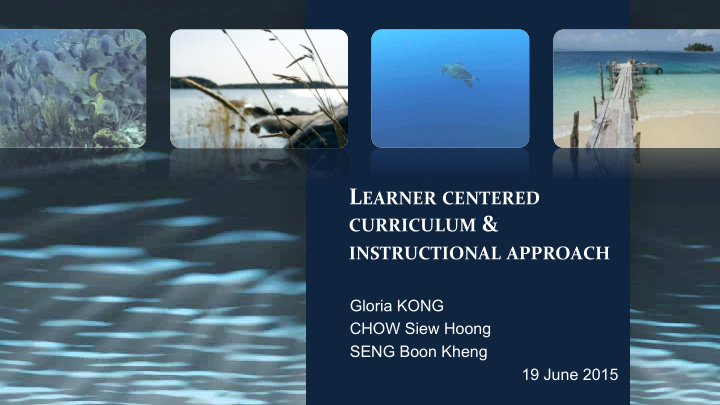



L EARNER ¡ CENTERED ¡ CURRICULUM ¡& ¡ INSTRUCTIONAL ¡ APPROACH ¡ Gloria KONG CHOW Siew Hoong SENG Boon Kheng 19 June 2015
Learner-Centred Curriculum and Instructional Approaches for Learning: A Design Analysis and Informal Observation
A ¡ CASE ¡ STUDY … ¡ Learner centred design Findings Our Approach
4 ¡K EY ¡D ESIGN ¡R EQUIREMENTS ¡ • Helping students to build prior knowledge • Providing opportunities for collaborative learning • Nurturing reasoning and critical thinking skills • Enabling self-directed learning
H ELPING ¡S TUDENTS ¡ TO ¡B UILD ¡P RIOR ¡K NOWLEDGE ¡ • i-study guide • Text book • Pre-class quizzes • Interactive self directed content
P ROVIDING ¡O PPORTUNITIES ¡ FOR ¡C OLLABORATIVE ¡L EARNING ¡ • Classroom learning • Discussion Board
N URTURING ¡R EASONING ¡ AND ¡C RITICAL ¡T HINKING ¡S KILLS ¡ ¡ • Assignments • Classroom sessions • Discussion Board
E NABLING ¡S ELF -‑ DIRECTED ¡L EARNING ¡ ¡ • Formative quizzes • Assignments
O UR ¡C ONCEPTUAL ¡F RAMEWORK ¡ In this course we help the students to build prior knowledge, provide opportunities for collaborative learning and nurture their reasoning and thinking skills – all these lead to enabling self directed learning.
O UR ¡T ARGET ¡V ARIABLES ¡ Empowering students for self-directed learning Nurturing critical thinking and reasoning skills
O UR ¡I NSTRUCTIONAL ¡A PPROACH ¡ Socratic reasoning Marzano’s dimension of learning
S OCRATIC ¡Q UESTIONING ¡ … students questions will be more often then not met with another question by instructor.
F OR ¡E XAMPLE … ¡ q Questions for clarification For example: How does this relate to our discussion? q Questions that probe assumptions For example: What could we assume instead? q Questions that probe reasons and evidence For example: What would be an example? q Questions about viewpoints and perspectives For example: What is another way to look at it? q Questions that probe implications and consequences For example: What are the consequences of that? q Questions about the question For example: Why do you think I asked this question?
5 ¡D IMENSIONS ¡ OF ¡L EARNING ¡(M ARZANO ¡& ¡P ICKERING , ¡2006) ¡
Using Knowledge Meaningfully Extending & Refining knowledge Acquiring & Integrating Knowledge
O UR ¡F INDINGS … ¡
S ELF -‑D IRECTED ¡L EARNING ¡ Written Assignment and classroom discussion: – Initiative and ability to find facts. – Careful synthesis of information. – Linking to personal experiences.
R EASONING ¡ AND ¡T HINKING ¡S KILLS ¡ Written Assignment & F2f sessions: – Conducting interview, then synthesise their observation. – Relating real live examples to theories. – Extending knowledge by relating to other examples .
¡ S TUDENT ’ S ¡O BSERVATION … ¡ ¡ “ … she always ask questions that helped us to think about the application of whatever we learned to our job” ~Student
D ISCUSSION ¡ • Readiness of students to self-direct • Meaningful collaboration • In-depth reasoning skills
C ONCLUSION ¡ Self-directed Learning & Reasoning/Thinking are skills students can learn. Applying them in their knowledge acquisition will enable students to have meaningful learning.
G IVE ¡ A ¡ MAN ¡ A ¡ FISH … ¡ ¡ ¡ ¡ ¡ ¡ ¡ HE ¡ WILL ¡ EAT ¡ THE ¡ FISH ¡ FOR ¡ THE ¡ DAY ; ¡ ¡ T EACH ¡ A ¡ MAN ¡ TO ¡ FISH … ¡ ¡ ¡ ¡ ¡ ¡ HE ¡ WILL ¡ EAT ¡ FISH ¡ FOR ¡ LIFE . ¡ ¡ ¡ ¡ ¡ ¡… ¡ OR ¡ WHENEVER ¡ HE ¡ LIKES ! ¡ -C HINESE P ROVERB -
Recommend
More recommend